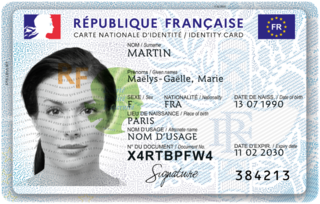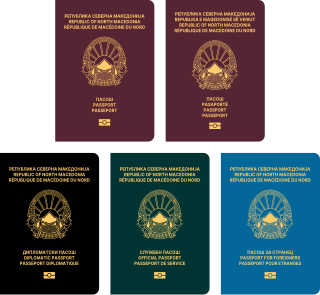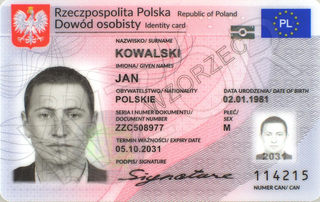Physical appearance
Since 1 September 2011, the residence permit is issued as ID-1 (credit card size) plastic cards with an embedded RFID chip. It is covered with multi-colour guillochés and appears pink-blue from the distance. All information on it is given only in German (except for the English words residence permit).
Front side
The front side shows the symbol for biometric travel documents, the German Eagle, the European bull, and the words "AUFENTHALTSTITEL" and "RESIDENCE PERMIT". It contains the following information:
- Photo of ID card holder (biometric photo)
- Document number (9 alphanumeric digits)
- Access number for RFID chip (6 decimal digits)
- Surname
- Given name(s)
- Validity of residence permit: date of expire or "UNBEFRISTET" (unlimited)
- Place of issue
- First day of validity (dd-mm-yyyy)
- type of document ("AUFENTHALTSERLAUBNIS" or "NIEDERLASSUNGSERLAUBNIS")
- Notes:
- Document number of corresponding passport
- Date of expire of corresponding passport (dd-mm-yyyy)
- If holder is permitted to work: "ERWERBSTÄTIGKEIT GESTATTET" (employment permitted)
- If additional provisions exist: "SIEHE ZUSATZBLATT" (see supplementary sheet)
- Signature of holder
Back side
The back side contains the following information:
Machine-readable zone
The three-line machine-readable zone on the back side contains the following information:
First line
| positions | text | meaning |
|---|
| 1-2 | AR | residence permit |
| 3 | D | issuing country: Germany (Deutschland) |
| 6-14 | alphanumeric digits | document number |
| 15 | decimal digit | check digit over 6-14 |
Second line
| positions | text | meaning |
|---|
| 1-6 | decimal digits | date of birth (YYMMDD) |
| 7 | decimal digit | check digit over 1-6 |
| 8 | alphabetic digit | sex (M or F) |
| 9-14 | decimal digits | date of expire of the residence permit (YYMMDD) |
| 15 | decimal digit | check digit over 9-14 |
| 16-18 | alphabetic digits | nationality of holder (three-letter code) |
| 30 | decimal digit | check digit over 6-30 (first line), 1–7, 9–15, 19-29 (second line) |
Third line
| positions | text | meaning |
|---|
| 1-30 | alphabetic digits<<alphabetic digits<alphabetic digits | SURNAME<< GIVEN<NAMES |
Empty spaces are represented by "<".
Chip
The residence permit contains a RFID chip. The chip stores the information given on the document (like name or date of birth), the holder's picture and, if the holder is at least 12 years old, also his/her fingerprints. The additional provisions are also stored on the chip. In addition, the new ID card can be used for online authentification (e.g. for age verification or for e-government applications). An electronic signature, provided by a private company, can also be stored on the chip.
The document number, the photo and the fingerprints can be read only by law enforcement agencies and some other authorities.
To use the online authentification function, the holder needs a six-digit decimal PIN. If the holder types in the wrong PIN, he has to type in the six-digit decimal access code given on the document to prove he/she really possesses the document. If the wrong PIN is used three times, a PUK must be used to unlock the chip. The data on the chip are protected by Basic Access Control and Extended Access Control.
Security features
The residence permit contains the following security features:
- multicoloured guillochés
- microprinting: EU and DEUTSCHLAND
- fluorescent elements:
- UV overprint: stars, lines, and EU luminesce in various colors under UV light
- randomly distributed fluorescent fibres which luminesce under UV light
- tactile features:
- access number for RFID chip is tactile
- surface embossing: map of Germany and microlettering
- security thread: colour changes when viewed under different angles; is personalized: NNNNNNNNNN<<SURNAME<<GIVEN<NAMES<<<<<<<<<< (NNNNNNNNNN is the document number including a check digit; a total of 42 digits can be found on the thread))
- changeable laser image: shows either the date of expire or the holder's portrait depending on angle
- color-changing ink: the colour of the biometric travel documents symbol changes from green to gold to red
- 2D and 3D holographic security elements:
- colour-changing holograms colour changes depending on angle (violet-blue-turquoise-green-yellow-orange-red)
- holographic portrait: holographic reproduction of the holder's picture
- four eagles at the left side of the holographic portrait: change their colour under a different angle than the portrait itself
- document number: NNNNNNNNN, 9 digits
- holder's name: SURNAME<<GIVEN<NAMES<<<<<<<<<<, 30 digits
- green kinematic structures above the conventional picture:
- EU Kinegram: bright E on dark background changes to dark E on bright background when document is tilted
- hexagon: moves across the picture when document is tilted
- stars: change their size when document is tilted
- text on the left side of the picture; visible only under a certain angle
- macrolettering: BUNDESREPUBLIK DEUTSCHLAND
- microlettering: BUNDESREPUBLIK DEUTSCHLAND BUNDESREPUBLIK DEUTSCHLAND BUNDESREPUBLIK DEUTSCHLAND
- machine-verifiable structure: a red spot which can be checked by machines
- 3D eagle: a red-gold eagle visible only under a certain angle
An identity document is any document that may be used to prove a person's identity. If issued in a small, standard credit card size form, it is usually called an identity card, or passport card. Some countries issue formal identity documents, as national identification cards that may be compulsory or non-compulsory, while others may require identity verification using regional identification or informal documents. When the identity document incorporates a person's photograph, it may be called photo ID.

The French national identity card is an official identity document consisting of an electronic ID-1 card bearing a photograph, name and address. While the identity card is non-compulsory, all persons must possess some form of valid government-issued identity documentation.

The Permanent Resident card also known colloquially as the PR Card or the Maple Leaf card, is an identification document and a travel document for permanent residents of Canada. It is one of the methods by which Canadian permanent residents can prove their status and is, along with the permanent resident travel document (PRTD), one of the only documents that allow permanent residents to return to Canada by a commercial carrier.

Serbian passport is the primary document of international travel issued to nationals of Serbia. Passports are issued and renewed by the Serbian Police on behalf of the Ministry of Internal Affairs or, if the citizen resides abroad, by the Serbian diplomatic missions. Besides serving as proof of identity and of citizenship, it facilitates the process of securing assistance from Serbian consular officials abroad, if needed.

The Montenegrin passport is the primary document for international travel issued by Montenegro.

A Norwegian passport is the passport issued to nationals of Norway for the purpose of international travel. Beside serving as proof of Norwegian citizenship, they facilitate the process of securing assistance from Norwegian consular officials abroad.

A German passport is an identity document issued to nationals of Germany for the purpose of international travel. A German passport is, besides the German ID card and the German Emergency Travel Document, the only other officially recognised document that German authorities will routinely accept as proof of identity from German citizens. Besides serving as proof of identity and presumption of German nationality, they facilitate the process of securing assistance from German consular officials abroad. German passports are valid for ten years or six years and share the standardised layout and burgundy red design with other EU passports. Every German citizen is also a citizen of the European Union. The passport, along with the national identity card, allows for free rights of movement and residence in any of the states of the European Union, European Economic Area and Switzerland.

Lithuanian passport is an official document, issued to Lithuanian citizens to identify themselves as such and/or to facilitate travel outside Lithuania. Every Lithuanian citizen is also a citizen of the European Union. The Lithuanian passport, along with the national identity card allows for free rights of movement and residence in any of the states of the European Union, European Economic Area and Switzerland.

A Dutch passport is an identity document issued to citizens of the Kingdom of the Netherlands for the purpose of international travel. As the Netherlands only distinguish one category of citizen, for all countries in the Kingdom, passports are the same for all four countries. The passport also serves as a means of identification as required by the Dutch law since 1 January 2005 for all persons over the age of fourteen. Dutch passports are valid for a period of ten years from issuing date. The passport complies with the rules for European Union passports. Since 26 August 2006 all passports are issued as a biometric passport with an embedded contactless smartcard RFID chip for storing biometric data. Every Dutch citizen is also a citizen of the European Union. The nationality allows for free rights of movement and residence in any of the states of the European Union, European Economic Area, and Switzerland.

The Swedish national identity card is a non-compulsory biometric identity document issued in Sweden. It is one of two official identity documents issued by the Swedish Police, the other being the Swedish passport. It is only issued to Swedish citizens, and indicates the citizenship.

North Macedonian passport are issued to citizens of North Macedonia for the purpose of international travel. Responsibility for their issuance lies with the Ministry of the Interior. The validity of the passport is 5 years for persons 4 to 27 years of age and 10 years for those 27 years of age and older. For children ages four and under, the validity of the passport is limited to two years. The passports conform to the recommended standards of the International Civil Aviation Organization (ICAO), and are biometric passports.

The Albanian passport is a travel document issued by the Ministry of Interior to Albanian citizens to enable them to travel abroad. They are also used as proof of identity within the country, along with the Albanian ID card.

The Mainland Travel Permit for Taiwan Residents, also known as the Taiwan Compatriot Permit, is a type of travel document issued by the Government of the People's Republic of China (PRC) to Republic of China nationals (ROC) who hold household registration in Taiwan. The document is issued by the Ministry of Public Security (MPS). Since the identity documents issued by the government of the Republic of China are not recognized in the PRC, the permit serves as both the main travel document and identity document for Taiwanese people in the PRC territory and is used on all occasions in lieu of a Taiwan passport.

Every Polish citizen 18 years of age or older residing permanently in Poland is required to have an identity card issued by the local office of civic affairs. Children as well as Polish citizens living permanently abroad are entitled, but not required, to have one. Identity cards are valid for a period of 10 years.

The Albanian identity card (Letërnjoftim) is a national identity card issued by Albanian authorities to Albanian citizens. It is proof of identity, citizenship and residence. The current version is in ID1 format and biometric. The ID card is compulsory for citizens over 16 years of age, costs 1,500 lekë and is valid for 10 years.

The German Identity Card is issued to German citizens by local registration offices in Germany and diplomatic missions abroad, while it is produced at the Bundesdruckerei in Berlin.

Documento Nacional de Identidad or DNI, is the main identity document for Argentine citizens, as well as temporary or permanent resident aliens. It is issued at a person's birth, and must be updated at 8 and 14 years of age, and thereafter every 15 years. It takes the form of a card, and is required for voting, payments, military service inscriptions and formalities. They are issued by the National Registry of Persons (RENAPER).
The Lebanese identity card is a compulsory Identity document issued to citizens of the Republic of Lebanon by the police on behalf of the Lebanese Ministry of Interior or in Lebanese embassies/consulates (abroad) free of charge. It is proof of identity, citizenship and residence of the Lebanese citizens.
Biometrics refers to the automated recognition of individuals based on their biological and behavioral characteristics, not to be confused with statistical biometrics; which is used to analyse data in the biological sciences. Biometrics for the purposes of identification may involve DNA matching, facial recognition, fingerprints, retina and iris scanning, voice analysis, handwriting, gait, and even body odor.
The Iraqi National Card is an electronic biometric card issued by the Ministry of Interior from January 1, 2016. It replaced the Nationality Certificate and Civil Identification Document and the Residency Card. This card has a high security platform and is connected directly to the Iraqi Civil System, and can be used to travel within Iraq and Arab countries.

















